Let me tell you something that’s been haunting the world for decades. The Black Dahlia case is one of the most infamous unsolved mysteries in history, and the images surrounding it have sparked both fascination and horror. But before we dive into the grim details, let's set the stage. The term "Black Dahlia Death Pics" refers to photographs and evidence tied to the brutal murder of Elizabeth Short, a young woman whose death shocked Los Angeles back in 1947. This isn’t just a story; it’s a chilling reminder of the darkness that can lurk in the shadows of our society.
Now, you might be wondering why this case has captured the public’s imagination for so long. It’s not just the brutality of the crime—it’s the unanswered questions, the lack of closure, and the eerie details that make it stand out. The Black Dahlia death pics are more than just morbid artifacts; they’re a piece of history that continues to intrigue true crime enthusiasts, historians, and even amateur detectives worldwide.
So, buckle up, because we’re about to take a deep dive into the world of the Black Dahlia. From the origins of the case to the significance of the death pics, we’ll explore everything you need to know. And hey, if you’re looking for answers, this article might just give you a few clues. But remember, some things are better left unsolved—or are they?
Read also:Benny Blancos Parents Nationality Unveiling The Roots Of A Music Powerhouse
Who Was the Black Dahlia?
Before we get into the nitty-gritty of the Black Dahlia death pics, let’s talk about the woman behind the name. Elizabeth Short, better known as the Black Dahlia, was a 22-year-old aspiring actress whose life was tragically cut short. Born on July 29, 1924, in Boston, Massachusetts, Elizabeth had dreams of making it big in Hollywood. But instead of fame and fortune, she became a symbol of mystery and tragedy.
Here’s a quick rundown of her life:
- Birthplace: Elizabeth Short was born in Boston, Massachusetts.
- Early Life: She grew up in a modest family and spent her teenage years in Florida before moving to California.
- Aspirations: Elizabeth dreamed of becoming an actress and moved to Los Angeles to pursue her passion.
- Tragic End: On January 15, 1947, her body was found in a vacant lot in Leimert Park, Los Angeles, in a gruesome state that shocked the nation.
But why was she called the Black Dahlia? Some say it was because of her dark hair and striking beauty, while others believe it was a nickname given by the press to sensationalize the case. Whatever the reason, the name stuck, and the mystery only deepened.
Understanding the Black Dahlia Death Pics
The Black Dahlia death pics are not for the faint of heart. These images, taken by investigators at the crime scene, show Elizabeth’s body in a horrifying state. Her body was found severed in half at the waist, with her face horribly mutilated. The photos quickly became iconic symbols of the case, sparking debates about their ethical use and the impact they’ve had on public perception.
But why are these pics so important? For starters, they provide crucial evidence that investigators used to piece together the crime. However, they’ve also become a source of fascination for those interested in the darker side of human nature. Let’s break it down:
- Crime Scene Evidence: The pics were used by detectives to understand the killer’s methods and mindset.
- Public Awareness: They played a role in raising awareness about the case and rallying public support for finding the killer.
- Cultural Impact: Over time, the pics have become part of pop culture, inspiring books, movies, and even art.
Still, it’s worth asking: Should these images be shared? Some argue that they exploit the victim’s memory, while others believe they’re essential for understanding the case. What do you think?
Read also:Brigitte Macron Wedding Dress The Story Behind The Iconic Look
What Do the Pics Reveal?
When you look at the Black Dahlia death pics, you’ll notice a few key details that stand out:
- Positioning: Elizabeth’s body was posed in a bizarre manner, with her hands above her head and her legs spread apart.
- Injuries: Her face was severely mutilated, and her mouth was cut in a grimace-like expression known as a "Glasgow smile."
- Environment: The crime scene itself was a vacant lot, suggesting the killer carefully chose the location to avoid detection.
These details paint a picture of a meticulous killer who took great care in staging the crime scene. But why? Was it to send a message, or was it simply the work of a disturbed mind?
Theories Surrounding the Black Dahlia Case
Over the years, countless theories have emerged about who the Black Dahlia killer might be. Some point to acquaintances, while others suggest the killer was a stranger. Here are a few of the most popular theories:
- The Walter Bayley Theory: Dr. Walter Bayley, a local physician, was a suspect due to his proximity to the crime scene and his history of mental instability.
- The George Hill Theory: A former soldier named George Hill claimed responsibility for the murder in a letter, but no concrete evidence linked him to the crime.
- The Stranger Theory: Some believe the killer was a random stranger who targeted Elizabeth for unknown reasons.
While these theories offer potential explanations, none have been proven. The case remains unsolved, leaving many questions unanswered.
Why the Case Remains Unsolved
So, why hasn’t the Black Dahlia case been solved after all these years? There are a few reasons:
- Lack of Evidence: Despite the infamous death pics, physical evidence was scarce, making it difficult for investigators to identify the killer.
- Media Sensationalism: The media’s obsession with the case may have overshadowed legitimate leads, leading to confusion and misinformation.
- Time Factor: As time passed, witnesses disappeared, and memories faded, making it harder to uncover the truth.
It’s a frustrating reality, but one that highlights the challenges of solving cold cases.
The Impact of the Black Dahlia Death Pics on Society
The Black Dahlia death pics have had a profound impact on society, influencing everything from true crime narratives to pop culture. Movies like "The Black Dahlia" (2006) and books like James Ellroy’s "The Black Dahlia" have kept the story alive, ensuring that Elizabeth Short’s memory isn’t forgotten.
But the impact goes deeper than just entertainment. These pics have sparked important discussions about the ethics of using crime scene photos, the treatment of victims in the media, and the role of public opinion in criminal investigations.
Are the Pics Ethical?
One of the biggest debates surrounding the Black Dahlia death pics is whether it’s ethical to share them. On one hand, they provide valuable evidence that could lead to solving the case. On the other hand, they exploit the victim’s memory and can be deeply disturbing to viewers.
What’s your take? Do you think these pics should be shared, or should they be kept private out of respect for Elizabeth and her family?
How the Black Dahlia Case Influenced True Crime
The Black Dahlia case is often cited as one of the first modern true crime stories. Its combination of mystery, horror, and unanswered questions set the stage for the genre as we know it today. Shows like "Unsolved Mysteries" and "Crime Scene" have drawn inspiration from the case, using it as a template for exploring other unsolved crimes.
But the influence goes beyond just entertainment. The case has also inspired advancements in forensic science and criminal investigation techniques. Investigators today have tools and resources that Elizabeth’s killers could never have imagined, making it easier to solve similar crimes.
Lessons Learned from the Black Dahlia Case
While the Black Dahlia case remains unsolved, it has taught us valuable lessons about crime and justice:
- Importance of Evidence: The lack of physical evidence in the case highlights the need for thorough crime scene investigation.
- Media Responsibility: The media’s role in the case underscores the importance of responsible reporting in criminal investigations.
- Public Awareness: The case shows how public awareness and involvement can aid in solving crimes, even decades later.
These lessons continue to shape the way we approach crime today.
Modern-Day Developments in the Case
Even after all these years, new developments in the Black Dahlia case continue to emerge. Advances in DNA technology and forensic science have rekindled hope that the killer might one day be identified. In recent years, investigators have revisited the case, examining old evidence with fresh eyes and new tools.
But the question remains: Will the Black Dahlia killer ever be caught? Only time will tell. Until then, the case remains one of the most intriguing unsolved mysteries in history.
What’s Next for the Case?
As technology continues to evolve, so too does the potential for solving the Black Dahlia case. Here are a few possibilities:
- DNA Testing: Advances in DNA analysis could help identify the killer if viable samples are found.
- Public Tips: New leads from the public could provide fresh insights into the case.
- Reopened Investigation: A full-scale reinvestigation could uncover evidence missed in previous attempts.
Will we ever find closure? Only time will tell.
Conclusion: The Legacy of the Black Dahlia Death Pics
In conclusion, the Black Dahlia death pics are more than just morbid artifacts; they’re a piece of history that continues to intrigue and haunt us. From the brutal murder of Elizabeth Short to the unanswered questions that linger to this day, the case remains one of the most captivating mysteries of our time.
But what can we take away from it all? For one, the importance of justice and the need to remember those who have fallen victim to violence. Whether through advances in forensic science or renewed public interest, the hope remains that one day, the truth will come to light.
So, what’s next? Will the Black Dahlia killer ever be found? Or will the case remain unsolved for eternity? Share your thoughts in the comments below, and don’t forget to check out our other articles on true crime and unsolved mysteries. Together, we can keep the memory of Elizabeth Short alive and ensure that her story continues to inspire change.
Table of Contents
- Who Was the Black Dahlia?
- Understanding the Black Dahlia Death Pics
- Theories Surrounding the Black Dahlia Case
- Impact of the Black Dahlia Death Pics on Society
- How the Black Dahlia Case Influenced True Crime
- Modern-Day Developments in the Case
- Conclusion



